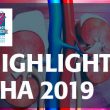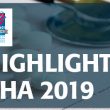1- AHA 2019 | ISCHEMIA: The Invasive Approach (PCI or Surgery) Results Similar to Optimal Medical Treatment After a several year follow up, the International Study of Comparative Health Effectiveness with Medical and Invasive Approaches (ISCHEMIA) has shown that an invasive approach in addition to optimal medical treatment (OMT) does not offer benefits when it<a href="https://solaci.org/en/2019/12/02/the-most-read-articles-of-november-at-solaci-org/" title="Read more" >...</a>
AHA 2019 | ISCHEMIA-CKD: Chronic Kidney Disease and Stable Coronary Disease
Among patients in the main ISCHEMIA trial, those with chronic kidney disease are a particularly high-risk subgroup. However, an invasive strategy with coronary angiography and revascularization did not improve the rate of events, similarly to what happened in the general population for the aforementioned trial. The rate of death or acute myocardial infarction was 36.4%<a href="https://solaci.org/en/2019/11/22/aha-2019-ischemia-ckd-chronic-kidney-disease-and-stable-coronary-disease/" title="Read more" >...</a>
AHA 2019 | COLCOT: Colchicine and the Return of the Anti-Inflammatory Theory
Low-dose colchicine seems to reduce the risk for new cardiovascular events in patients with a history of infarction. This drug is usually indicated for anti-inflammatory therapy in gout and pericarditis. Now, it could also reduce the rate of ischemic events as secondary prevention according to the COLCOT trial presented during the American Heart Association (AHA)<a href="https://solaci.org/en/2019/11/20/aha-2019-colcot-colchicine-and-the-return-of-the-anti-inflammatory-theory/" title="Read more" >...</a>
The Real Impact of Peripheral Artery Disease in TAVR
Courtesy of Dr. Carlos Fava. The real incidence of peripheral artery (PAD) disease in TAVR remains unclear. Different reports still estimate it is between 10 and 46%, but they have shown it has a negative impact in evolution. 51,685 TAVR patients were analyzed. 12,740 of these patients presented PAD (24.6%). PAD patients tended to be<a href="https://solaci.org/en/2019/09/11/the-real-impact-of-peripheral-artery-disease-in-tavr/" title="Read more" >...</a>
ESC 2019 | COMPLETE: Definitive Evidence for Infarction with Multivessel Disease
For patients with ST-segment elevation acute myocardial infarction and multivessel disease beyond the culprit artery, complete revascularization is superior to culprit-only treatment as regards the final endpoint, a composite of cardiovascular death, infarction, and ischemia-driven revascularization over a mean follow-up of 3 years. This information derives from long-awaited randomized study COMPLETE, finally presented at the<a href="https://solaci.org/en/2019/09/05/esc-2019-complete-definitive-evidence-for-infarction-with-multivessel-disease/" title="Read more" >...</a>
ESC 2019 | ISAR-REACT 5 | Which Is Better in ACS, Prasugrel or Ticagrelor?
Courtesy of Dr. Carlos Fava. The benefit of dual antiplatelet therapy in acute coronary syndromes (ACS) has been proven long ago, and both prasugrel and ticagrelor have offered best results than clopidogrel. However, nowadays, it is unclear which of them is superior in the long term, taking into account the fact that one starts to<a href="https://solaci.org/en/2019/09/05/esc-2019-isar-react-5-which-is-better-in-acs-prasugrel-or-ticagrelor/" title="Read more" >...</a>
The Most Read Articles of July in solaci website
1-Though Systolic BP Seems More Important, Diastolic BP Should Not Be Disregarded Systolic hypertension is more often associated to cardiovascular events. However, diastolic blood pressure should not be disregarded, since it can also predict even worse outcomes. Read more HERE 2-After Much Toing and Froing, Gastrointestinal Protection Is Back to the Forefront Several clinical guidelines<a href="https://solaci.org/en/2019/08/30/the-most-read-articles-of-july-in-solaci-website/" title="Read more" >...</a>
FFR to Predict CABG Result: All Benefits in a Population Much Too Pure?
Coronary artery bypass graft (CABG) anastomosed to one vessel with normal or nearly normal fractional flow reserve (FFR) have poorer graft patency at one year compared against anastomosed grafts to vessels with functionally significant lesions shown by FFR. However, the recent study FARGO (Fractional Flow Reserve Versus Angiography Randomization for Graft Optimization) did not show<a href="https://solaci.org/en/2019/08/16/ffr-to-predict-cabg-result-all-benefits-in-a-population-much-too-pure/" title="Read more" >...</a>
Surprising EXCEL Outcomes in Diabetics with Main Left Stenosis
This study especially designed to compare PCI vs. CABG in patients with left main coronary artery disease and low to intermediate Syntax score showed that 30-day and 3 -year outcomes of PCI with everolimus eluting stents vs CABG were consistent both in diabetic and non-diabetic patients. The randomized EXCEL trial (Evaluation of XIENCE versus Coronary<a href="https://solaci.org/en/2019/05/09/surprising-excel-outcomes-in-diabetics-with-main-left-stenosis/" title="Read more" >...</a>
Would TAVR Have a Similar Benefit in Patients with Low Flow, Low Gradient, and Preserved Ejection Fraction?
Courtesy of Dr. Carlos Fava. Patients with low-flow low-gradient severe aortic stenosis are at higher risk, but there is a low-flow low-gradient group with preserved ejection fraction. These patients present systolic and diastolic ventricular dysfunction and their progress is different than that of the high-flow high-gradient normal ventricular function group. This study analyzed 1462 patients. Among them,<a href="https://solaci.org/en/2019/05/07/would-tavr-have-a-similar-benefit-in-patients-with-low-flow-low-gradient-and-preserved-ejection-fraction/" title="Read more" >...</a>









